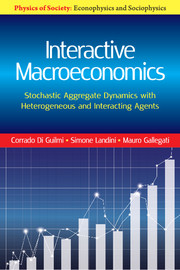1 - Introduction
Published online by Cambridge University Press: 23 July 2017
Summary
The economy is full of puzzles that arise
from the fact that reality stubbornly refuses
to obey the most outlandish and improbable mainstream hypotheses.
If only the empirical evidence would be less dull.
DOMENICO DELLI GATTIThis chapter provides the rationale of the book together with a reading road-map. Section 1.1 identifies the historical and methodological reasons for the current impasse in macroeconomics, while Section 1.2 offers some remarks about the issue of aggregation. The motivation for modelling economies with heterogeneous interacting agents, the necessity of coupling ACE (agent-based computational economics) and ASHIA (analytical solution to heterogeneous interacting agent-based models) and the ME (master equation) approach that the book suggests are discussed in Section 1.3. Finally, Section 1.4 details the structure of the book.
Why are We Here?
Magma, something in between solid and liquid states, describes well the state of macroeconomics today. Since after the Great Recession, it has been possible to find reports of deep states of disaffection (Solow, 2008) vis a vis comfortable views (Blanchard, 2008). However, the more relaxing approach has caveats of such a magnitude to alert even the quietest reader. According to their proponents, two (out of three) equations of the new Keynesian dynamic stochastic general equilibrium (DSGE) are manifestly wrong, while the methodology based on the representative agent (RA) cannot be reconciled with the empirical evidence. Lakatos (1978) would have described the present state of mainstream macroeconomics as having clear signs of a failing paradigm.
Economics is slowly moving from the classical physics to the statistical physics paradigm, from determinism to stochasticity, from equilibrium to interaction and complexity. That is a passage, from the isolated not interacting individual to a stochastically interactive framework, which generates an emergent macroeconomics (Delli Gatti et al., 2008).
Although speaking the language of probability and stochastic processes theory, which is familiar to economists, this book argues for the adoption of tools widely developed in the field of statistical physics. The introduction of this approach is not without consequences in the corpus of economic thought. As will be clearer in what follows, this modifies the characteristics of the equilibrium and the interpretation of dynamics, implying a change in the economic paradigm. The Great Recession is not due to mainstream economics virtues attributed to the market theory; but it has been worsened by a bizarre theoretical interpretation of the markets.
- Type
- Chapter
- Information
- Interactive MacroeconomicsStochastic Aggregate Dynamics with Heterogeneous and Interacting Agents, pp. 1 - 26Publisher: Cambridge University PressPrint publication year: 2016



